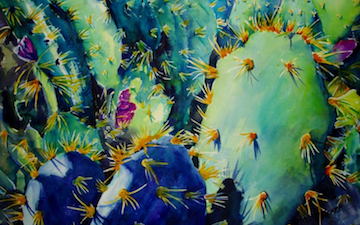Like all true cactus species, prickly pears are native only to the Western hemisphere; however, they have been introduced to other parts of the globe. Prickly pear species are found in abundance in Mexico, especially in the central and western regions. They are also found in the Western United States, in arid regions in the Northwest, throughout the mid and lower elevations of the Rocky Mountains such as in Colorado, where species such as Opuntia phaeacantha, Opuntia polyacantha and others become dominant, and especially in the desert Southwest. Prickly pears are also the only types of cactus found to grow natively far east of the Great Plain.
Shrubs, spreading to sprawling, forming large clumps, to 1 × 1-9 m. Stem segments not disarticulating, green, flattened, elliptic to obovate to rhombic, 15-25(-40) × 6.5-14 cm, ± tuberculate, glabrous, usually glaucous; areoles 5-7(-8) per diagonal row across midstem segment, prominent, subcircular(-oval), 4-6 × 4-5 mm, enlarging in age; wool gray. Spines 4-11 per areole, in most areoles, yellow with chalky white coat, to yellow with red-brown basal portions, aging reddish gray; erect ones terete, stout, straight; abaxial ones reflexed, shorter, to 12 mm; adaxial spines spreading, longest spines 20-40 mm. Glochids moderately dense in crescent at adaxial edge of areole, merging with subapical tuft when present, yellow to red-brown, to 5 mm. Flowers: inner tepals yellow to dull red throughout, 35-45 mm; filaments yellow to orange-yellow; anthers yellow; style pink to red; stigma lobes yellow-green to green. Fruits dark red-purple throughout, obovoid, 35-50 × 30-35 mm, juicy, glabrous, spineless; areoles 22-36. Seeds gray, subcircular, warped, 3-4.5 mm diam.; girdle protruding 0.5 mm. 2n = 66.
Shrubs, spreading to sprawling, forming large clumps, to 1 × 1-9 m. Stem segments not disarticulating, green, flattened, elliptic to obovate to rhombic, 15-25(-40) × 6.5-14 cm, ± tuberculate, glabrous, usually glaucous; areoles 5-7(-8) per diagonal row across midstem segment, prominent, subcircular(-oval), 4-6 × 4-5 mm, enlarging in age; wool gray. Spines 4-11 per areole, in most areoles, yellow with chalky white coat, to yellow with red-brown basal portions, aging reddish gray; erect ones terete, stout, straight; abaxial ones reflexed, shorter, to 12 mm; adaxial spines spreading, longest spines 20-40 mm. Glochids moderately dense in crescent at adaxial edge of areole, merging with subapical tuft when present, yellow to red-brown, to 5 mm. Flowers: inner tepals yellow to dull red throughout, 35-45 mm; filaments yellow to orange-yellow; anthers yellow; style pink to red; stigma lobes yellow-green to green. Fruits dark red-purple throughout, obovoid, 35-50 × 30-35 mm, juicy, glabrous, spineless; areoles 22-36. Seeds gray, subcircular, warped, 3-4.5 mm diam.; girdle protruding 0.5 mm. 2n = 66.
(From EOL, 1 March 2011)




